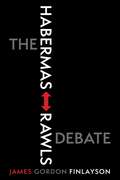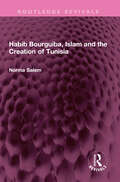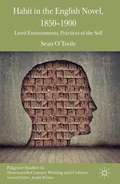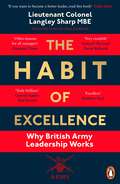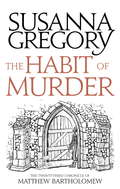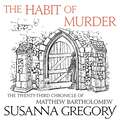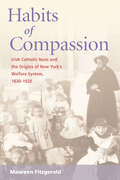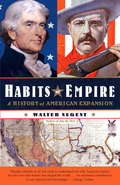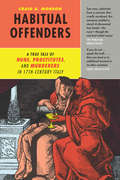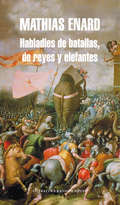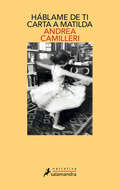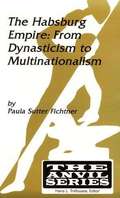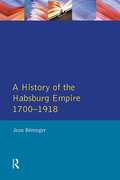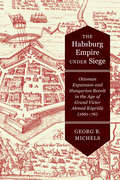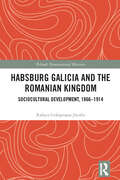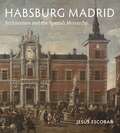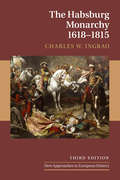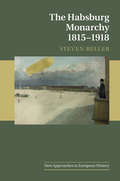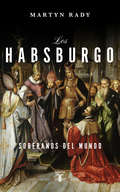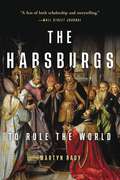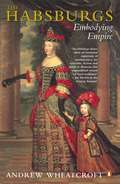- Table View
- List View
The Habermas-Rawls Debate
by James Gordon FinlaysonJürgen Habermas and John Rawls are perhaps the two most renowned and influential figures in social and political philosophy of the second half of the twentieth century. In the 1990s, they had a famous exchange in the Journal of Philosophy. Quarreling over the merits of each other’s accounts of the shape and meaning of democracy and legitimacy in a contemporary society, they also revealed how great thinkers working in different traditions read—and misread—one another’s work.In this book, James Gordon Finlayson examines the Habermas-Rawls debate in context and considers its wider implications. He traces their dispute from its inception in their earliest works to the 1995 exchange and its aftermath, as well as its legacy in contemporary debates. Finlayson discusses Rawls’s Political Liberalism and Habermas’s Between Facts and Norms, considering them as the essential background to the dispute and using them to lay out their different conceptions of justice, politics, democratic legitimacy, individual rights, and the normative authority of law. He gives a detailed analysis and assessment of their contributions, assessing the strengths and weaknesses of their different approaches to political theory, conceptions of democracy, and accounts of religion and public reason, and he reflects on the ongoing significance of the debate. The Habermas-Rawls Debate is an authoritative account of the crucial intersection of two major political theorists and an explication of why their dispute continues to matter.
Habib Bourguiba, Islam and the Creation of Tunisia (Routledge Revivals)
by Norma SalemFirst published in 1984, Habib Bourguiba, Islam and the Creation of Tunisia is a study of Habib Bourguiba, the founder of independent Tunisia, that argues that Islam played a vital role in the development of the Tunisian nationalist movement. This book is therefore both a biography of the Tunisian leader and a discussion of the role of Islam as the key to legitimacy throughout the Arab world. The author argues that Islam was such a fundamental component in defining the specificity of the Tunisian nation that even Bourguiba, the most secular of Arab leaders, could not shed the Arab-Islamic heritage of Tunisia. Instead, he used Islam as a principle mode of communication to mobilise the Tunisian masses. This book will be of interest to students of African studies, history, political science and religion.
Habit in the English Novel, 1850–1900: Lived Environments, Practices of the Self (Palgrave Studies in Nineteenth-Century Writing and Culture)
by Sean O’TooleThe ancient philosophical concept of habit fixated and unsettled the Victorians in profoundly new ways, as advances in physiology and evolutionary theory sparked far-reaching debates about the threat of automatism and the proper mental training of the will. This book suggests that nineteenth-century novelists not only echoed these debates but intervened in them in unique, transformative, and strikingly modern ways. In attending closely to the enabling, generative potential of habit and its role in the creation of new perceptions and social identities, novelists from Dickens to James bequeathed a far more complex conception of the category than has yet been acknowledged, allowing for a rich phenomenology of the unpredictable, changeable modes of modern existence. Habit in the English Novel, 1850-1900 reconsiders what we have come to assume about the Victorian novel, including our own critical habits, in the wake of Freud and cultural modernism.
The Habit of Excellence: Why British Army Leadership Works
by Lt Col Langley SharpThe official British Army book on what makes its leadership so successful, and how to become a better leader yourself - whatever your field. ___________________'If you want to become a better leader, read this book' Eddie Jones'An extraordinary read for any leader. Truly brilliant' General Stanley McChrystal, author of Team of Teams'Excellent. Offers proven tools and strategies' Matthew Syed___________________ The Habit of Excellence is a unique insight into British Army leadership, explaining what makes it unique, what makes it so effective and what civilians can take from it to become better leaders themselves. Drawing on the latest research in military history, business, sociology, psychology and behavioural science, and with compelling illustration from British Army operations across the centuries, Lt Col Langley Sharp MBE goes beyond the latest leadership fads to distil into one peerlessly authoritative work the essence of leading and leadership from one of the world's most revered institutions.___________________'Excellent. It's hard to see how any leader, whatever their field, wouldn't benefit from reading and rereading it' New Statesman 'Offers lessons for all managers' Financial Times 'Valuable in any walk of life' General Sir Mike Jackson, former Chief of the General Staff 'Very readable. I could not recommend this exceptional book more' General The Lord David Richards, former Chief of the Defence Staff 'Comprehensive and clearly written' Karin von Hippel, Director-General of RUSI 'Terrific. Full of insights and lessons' General David Petraeus, former Director of the CIA
The Habit of Murder: The Twenty Third Chronicle of Matthew Bartholomew (Chronicles of Matthew Bartholomew #23)
by Susanna GregoryFor the twentieth anniversary of the start of the Matthew Bartholomew series, Sphere is delighted to reissue all of the medieval monk's cases with beautiful new series-style covers.------------------------------------The twenty third chronicle of Matthew Bartholomew. In 1360 a deputation from Cambridge ventures to the Suffolk town of Clare in the hope that the wealthy Elizabeth de Burgh has left a legacy to Michaelhouse. Yet when they arrive they discover that the report of her death is false and that the college seems destined for bankruptcy.Determined to see if some of its well-heeled citizens can be persuaded to sponsor Michaelhouse, Matthew Bartholomew, Brother Michael and Master Langelee become enmeshed in the town's politics. They quickly discover that a great many other people in Clare have recently met untimely deaths. These killings, combined with the arrogance Lady de Burgh has shown over the refurbishment of the church and the grotesque behaviour of some of her entourage, have created a dangerous restlessness in the town: an atmosphere intensified when yet more murders occur.One of the victims is a fellow traveller of the Michaelhouse contingent, and Matthew Bartholomew and Brother Michael feel honour-bound to identify his killer. It is a hunt which takes them deep into Clare's murky foundations and which threatens their own survival as well as that of their beloved college.'A first-rate treat for mystery lovers' (Historical Novels Review)'Susanna Gregory has an extraordinary ability to conjure up a strong sense of time and place' (Choice)
The Habit of Murder: The Twenty Third Chronicle of Matthew Bartholomew
by Susanna GregoryIn 1360 a deputation from Cambridge ventures to the Suffolk town of Clare in the hope that the wealthy Elizabeth de Burgh has left a legacy to Michaelhouse. Yet when they arrive they discover that the report of her death is false and that the college seems destined for bankruptcy.Determined to see if some of its well-heeled citizens can be persuaded to sponsor Michaelhouse, Matthew Bartholomew, Brother Michael and Master Langelee become enmeshed in the town's politics. They quickly discover that a great many other people in Clare have recently met untimely deaths. These killings, combined with the arrogance Lady de Burgh has shown over the refurbishment of the church and the grotesque behaviour of some of her entourage, have created a dangerous restlessness in the town: an atmosphere intensified when yet more murders occur.One of the victims is a fellow traveller of the Michaelhouse contingent, and Matthew Bartholomew and Brother Michael feel honour-bound to identify his killer. It is a hunt which takes them deep into Clare's murky foundations and which threatens their own survival as well as that of their beloved college.
The Habit of Murder: The Twenty Third Chronicle of Matthew Bartholomew (Chronicles of Matthew Bartholomew #23)
by Susanna GregoryThe twenty third chronicle of Matthew Bartholomew. In 1360 a deputation from Cambridge ventures to the Suffolk town of Clare in the hope that the wealthy Elizabeth de Burgh has left a legacy to Michaelhouse. Yet when they arrive they discover that the report of her death is false and that the college seems destined for bankruptcy.Determined to see if some of its well-heeled citizens can be persuaded to sponsor Michaelhouse, Matthew Bartholomew, Brother Michael and Master Langelee become enmeshed in the town's politics. They quickly discover that a great many other people in Clare have recently met untimely deaths. These killings, combined with the arrogance Lady de Burgh has shown over the refurbishment of the church and the grotesque behaviour of some of her entourage, have created a dangerous restlessness in the town: an atmosphere intensified when yet more murders occur.One of the victims is a fellow traveller of the Michaelhouse contingent, and Matthew Bartholomew and Brother Michael feel honour-bound to identify his killer. It is a hunt which takes them deep into Clare's murky foundations and which threatens their own survival as well as that of their beloved college.'A first-rate treat for mystery lovers' (Historical Novels Review)'Susanna Gregory has an extraordinary ability to conjure up a strong sense of time and place' (Choice)
Habits of Compassion: Irish Catholic Nuns and the Origins of New York's Welfare System, 1830-1920 (Women, Gender, and Sexuality in American History)
by Maureen FitzgeraldThe Irish-Catholic Sisters accomplished tremendously successful work in founding charitable organizations in New York City from the Irish famine through the early twentieth century. Maureen Fitzgerald argues that their championing of the rights of the poor—especially poor women—resulted in an explosion of state-supported services and programs. Parting from Protestant belief in meager and means-tested aid, Irish Catholic nuns argued for an approach based on compassion for the poor. Fitzgerald positions the nuns' activism as resistance to Protestantism's cultural hegemony. As she shows, Roman Catholic nuns offered strong and unequivocal moral leadership in condemning those who punished the poor for their poverty and unmarried women for sexual transgression. Fitzgerald also delves into the nuns' own communities, from the class-based hierarchies within the convents to the political power they wielded within the city. That power, amplified by an alliance with the local Irish Catholic political machine, allowed the women to expand public charities in the city on an unprecedented scale.
Habits of Empire: A History of American Expansion
by Walter NugentDiscussions abound today about the state of the union, its place in the world, and the founding fathers' intentions. Did they want the United States to become a republic or an empire? Thomas Jefferson, after all, called the young nation an "empire for liberty." Later words through two centuries all evoked empire: "manifest destiny" in the 1840s, "benevolent assimilation" in 1898, and "our responsibility to lead" in 2002. Indeed, since Jefferson's day, Americans have proudly proclaimed liberty and cherished democracy even as they have often behaved imperially. Habits of Empire documents this expansionist behavior by examining each of the nation's territorial acquisitions since the first in 1782--how the land was acquired, how its previous occupants were removed or reduced, and how it was then settled and stabilized. By 1853, when the continental United States was fully established from sea to shining sea, the nation's habit of empire-building had become firmly formed. Each of the acquisitions is a story in itself. In Paris in 1782, the American negotiators--the crafty Benjamin Franklin, the crabby John Adams, and the crooked John Jay--stubbornly and with much luck pushed the new country's western boundary to the Mississippi River and almost gained southern Canada as well. Hardly any Americans yet lived west of the Appalachians, and their armies had not conquered the region, but they won it nevertheless. That allowed Robert Livingston and James Monroe in 1803 to accept Napoleon's astonishing offer to sell all of Louisiana. Through a volatile mix of leadership, luck, aggression, chicanery, rampant population growth, and self-confident ideology came the further acquisitions of Florida, Texas, Oregon, and the Southwest. From the 1850s through the 1920s, America's empire-building reached across the Pacific (from Alaska through Hawaii and Samoa to the Philippines) and around the Caribbean (from Cuba, Puerto Rico, and several "protectorates" to the Panama Canal and the Virgin Islands). After 1945, American expansion took a new global form, military and economic, and built on the need to contain the Soviet Union in the Cold War. After 2001 and the start of the "war on terror," it became both defensive and assertive. Acclaimed historian Walter Nugent shows how the United States, asserting republican virtue but employing imperial force, has long lived with the contradiction inherent in Jefferson's famous phrase "empire for liberty." Enlightening, empathetic, comprehensive, and well-sourced, this book explains the deep roots of America's imperialism as no other has done.
Habitual Offenders: A True Tale of Nuns, Prostitutes, and Murderers in Seventeenth-Century Italy
by Craig A. MonsonIn April 1644, two nuns fled Bologna's convent for reformed prostitutes. A perfunctory archiepiscopal investigation went nowhere, and the nuns were quickly forgotten. By June of the next year, however, an overwhelming stench drew a woman to the wine cellar of her Bolognese townhouse, reopened after a two-year absence--where to her horror she discovered the eerily intact, garroted corpses of the two missing women. Drawing on over four thousand pages of primary sources, the intrepid Craig A. Monson reconstructs this fascinating history of crime and punishment in seventeenth-century Italy. Along the way, he explores Italy's back streets and back stairs, giving us access to voices we rarely encounter in conventional histories: prostitutes and maidservants, mercenaries and bandits, along with other "dubious" figures negotiating the boundaries of polite society. Painstakingly researched and breathlessly told, Habitual Offenders will delight historians and true-crime fans alike.
Habladles de batallas, de reyes y elefantes
by Mathias ÉnardUna crónica deslumbrante sobre un episodio confinado al olvido: las andanzas de Miguel Ángel en la Constantinopla renacentista, que funge también como una reflexión extraordinaria sobre la creación, las pasiones del artista y el punto donde confluyen dos civilizaciones. Al desembarcar en Constantinopla el 13 de mayo de 1506, Miguel Ángel sabe que está desafiando el poder y la cólera de Julio II, papa guerrero y mal pagador, por abandonar la construcción de su tumba en Roma. Pero ¿cómo rehusar la invitación del sultán Beyazid, que le propone, después de rechazar el diseño de Leonardo da Vinci, concebir un puente sobre el Cuerno de Oro? Así comienza esta novela, íntimamente ligada a la historia, que parte de un hecho real para después intentar desentrañar los misterios de aquel viaje. Abrumadora como el encuentro del hombre del Renacimiento con las bellezas del mundo otomano, precisa y cincelada como una pieza de orfebrería, Habladles de batallas, de reyes y elefantes es el retrato de un artista en su esplendor y, también, una fascinante reflexión acerca del acto de crear y el significado que esconde un gesto inacabado hacia la otra orilla de la civilización. A través de la crónica de estas semanas olvidadas de la historia, Mathias Enard esboza una geografía política cuyas dudas siguen acuciándonos cinco siglos después. * Habladles de batallas, de reyes y elefantes fue galardonada con el Premio Goncourt de los Estudiantes 2010. * Mathias Enard ha sido galardonado con el Premio Goncourt 2015 por su obra Brújula. Reseñas:«Una pequeña joya de elegancia intelectual.»La Vie Littéraire «¡Lo que le hubiera gustado a Orhan Pamuk diseñar esta espléndida novela-puente!»Ricard Ruiz Garzón, Qué leer «El texto conquista desde el primer capítulo por la belleza de un estilo siempre preciso. Las frases breves juegan con el ritmo, las palabras, la lírica, la poesía.»elcultural.es «Habladle de batallas, de reyes y elefantes habla sobre todo del corazón de los hombres y, como el texto de Kipling de donde toma su nombre, de los poderes del relato capaz de levantar puentes entre Oriente y Occidente.»Le Monde «Delicia. Esa es la primera palabra que me viene a la cabeza si tengo que elegir solo una para definir Habladles de batallas, de reyes y elefantes, aunque bien es cierto que podría acabar quedándome sin adjetivos suficientes para este buen libro, porque la verdad es que Mathias Enard ha conseguido una novela redonda de esas que cada vez escasean más.»Papelenblanco.com
Háblame de ti. Carta a Matilda
by Andrea CamilleriAndrea Camilleri, el querido maestro de la novela negra fallecido en julio de 2019, escribe una carta a su bisnieta Matilda. En ella repasa los episodios más representativos de su trayectoria personal y profesional junto con los hechos históricos más notables del último siglo. ____________________ Matilda, querida mía: Te escribo esta larga carta a pocos días de cumplir noventa y dos años, cuando tú tienes casi cuatro y todavía no sabes lo que es el alfabeto. Espero que puedas leerla en la plenitud de tu juventud. Te escribo a ciegas, tanto en sentido literal como figurado. En sentido literal, porque en los últimos años la vista me ha ido abandonando poco a poco. Ahora ya no puedo ni leer ni escribir, solo dictar. En sentido figurado, porque no consigo imaginarme cómo será el mundo dentro de veinte años, ese mundo en que te tocará vivir.____________________ Mientras Andrea Camilleri está trabajando, su bisnieta se mete a escondidas debajo de la mesa para jugar. En ese momento tan sencillo como íntimo, el escritor descubre que no quiere que sean los demás los que le cuenten a la niña, cuando se haga mayor, cómo era su bisabuelo. Así nace esta carta, que recorre toda una vida con la inteligencia del corazón, iluminando los momentos que han hecho de Camilleri el escritor y el hombre que todos adoramos. A través de sus páginas, el autor nos pasea por sus recuerdos, llevándonos a un espectáculo teatral que cuenta con la presencia del ministro fascista Pavolini, o a unas extraordinarias clases de dirección en la Academia Nacional de Arte Dramático de la mano de Silvio d'Amico; asimismo, rememora una matanza perpetrada por la mafia en Porto Empedocle, las palabras de un anciano actor tras un ensayo, el día que conoció a su mujer, Rosetta, y a su editora, Elvira Sellerio... Con sentido del humor y lucidez, en estas páginas se recorre la historia de Italia en el siglo XX en paralelo a la de un hombre enamorado de la vida y de sus personajes. Cada nuevo episodio es una oportunidad para hablar de lo que hace que valga la pena vivir la vida: las raíces, el amor, los amigos, la política, la literatura... Y siempre con el valor de no eludir los errores ni las desilusiones, y con la emoción de un bisabuelo que tan sólo puede imaginar el futuro y entregar (a Matilda y a nosotros) el testigo precioso de la duda.
The Habsburg Empire: From Dynasticism to Multinationalism
by Paula S. FichtnerDr. Fichtner presents a concise summary of the development and problems of the Habsburg Empire as a multi-ethnic state from the sixteenth century to the end of World War I. Twenty-six documents, some from local journals and periodicals of the era, illustrate the political, cultural, and economic relations of the Habsburg peoples, both with their rulers and with one another.
The Habsburg Empire: A New History
by Pieter M. JudsonThis panoramic reappraisal shows why the Habsburg Empire mattered for so long to so many Central Europeans across divides of language, religion, and region. Pieter Judson shows that creative government--and intractable problems the far-flung empire could not solve--left an enduring imprint on successor states. Its lessons are no less important today.
The Habsburg Empire 1700-1918
by Jean Berenger C.A. SimpsonThis is the eagerly awaited second volume of Jean Bérenger's history of the Habsburgs. It covers the last two centuries of their rule and provides a compelling account of the fluctuations of Habsburg dynastic power and its disintegration after World War One. Bérenger gives a rich portrait of Habsburg greatness under Maria Theresa and Joseph II and shows how their successors proved more adroit at riding the tide of nationalism in their multi-ethnic empire than is often recognised.
The Habsburg Empire under Siege: Ottoman Expansion and Hungarian Revolt in the Age of Grand Vizier Ahmed Köprülü (1661–76)
by Georg B. MichelsDuring the seventeenth century Hungary's diverse population of peasants, townsmen, soldiers, and county nobles rose up against the violent imposition of the Counter-Reformation, the Habsburg military occupation, and exhorbitant war taxes. In The Habsburg Empire under Siege Georg Michels explores the little-known grassroots revolts that threatened the Habsburgs' hold over the Hungarian borderlands.Based on extensive research in Hungarian, Austrian, and Dutch archives, this revisionist study shifts attention away from high politics, diplomacy, and military confrontation to the popular revolts that took place during the two decades before the 1683 siege of Vienna. Michels reveals a complex environment in which Calvinist Hungarians, Lutheran Slovaks, Lutheran Germans, and Orthodox Ukrainians worked to defend their religion against brutal Habsburg Counter-Reformation campaigns. Challenging preconceived notions of European, Middle Eastern, and East European history, this book tells a dramatic story of Reformation and Counter-Reformation violence, covering proxy wars, guerrilla warfare, refugee flight, migration from Hungary into Ottoman territory, and largely unknown Christian-Muslim encounters. Offering a trans-imperial perspective that reassesses the complex relationship between Hungarians, Habsburgs, and Ottomans, The Habsburg Empire under Siege portrays the resistance of ordinary men and women and their hopes for liberation from Habsburg oppression, reclaiming their place in history.
Habsburg Galicia and the Romanian Kingdom: Sociocultural Development, 1866–1914 (Poland: Transnational Histories)
by Raluca Goleșteanu-JacobsThis comparative attempt, intended for postgraduates and scholars of Eastern-Central Europe, investigates the political, economic, and cultural landscape of Habsburg Galicia and the Romanian Kingdom in the second half of the 19th century. Often, in historiography and in the public sphere alike, the two cases under study have been separately regarded as contexts that provided atypical answers to modernity, and parts of a region that has been regarded as atypical in itself. Recently, efforts have been made to integrate each of the cases in a post-imperial paradigm, identifying the complex interactions between their socio-political modernisation and historical memory. This book continues this trend by investigating for the first time the two cases together, as parts of a space of alterity, as labs of shifting ideologies and labels. The public figures and the institutions depicted in the book are physically located in Central and in Eastern Europe, but by sometimes competing experiences they are illustrative for several identities and historical realms, local, regional, and continental. Secondly, the current work addresses dilemmas related to Nationalism and nation building, for the sake of separating those discourses which reflected on civic nationalism from those which directed the public mind to the values of ethnic nationalism.
Habsburg Madrid: Architecture and the Spanish Monarchy
by Jesús EscobarWith its selection as the court of the Spanish Habsburgs, Madrid became the de facto capital of a global empire, a place from which momentous decisions were made whose implications were felt in all corners of a vast domain. By the seventeenth century, however, political theory produced in the Monarquía Hispánica dealt primarily with the concept of decline. In this book, Jesús Escobar argues that the buildings of Madrid tell a different story about the final years of the Habsburg dynasty.Madrid took on a grander public face over the course of the seventeenth century, creating a "court space" for residents and visitors alike. Drawing from the representation of the city’s architecture in prints, books, and paintings, as well as re-created plans standing in for lost documents, Escobar demonstrates how, through shared forms and building materials, the architecture of Madrid embodied the monarchy and promoted its chief political ideals of justice and good government. Habsburg Madrid explores palaces, public plazas, a town hall, a courthouse, and a prison, narrating the lived experience of architecture in a city where a wide roster of protagonists, from architects and builders to royal patrons, court bureaucrats, and private citizens, helped shape a modern capital.Richly illustrated, highly original, and written by a leading scholar in the field, this volume disrupts the traditional narrative about seventeenth-century Spanish decadencia. It will be welcomed by specialists in Habsburg Spain and by historians of art, architecture, culture, economics, and politics.
Habsburg Madrid: Architecture and the Spanish Monarchy
by Jesús EscobarWith its selection as the court of the Spanish Habsburgs, Madrid became the de facto capital of a global empire, a place from which momentous decisions were made whose implications were felt in all corners of a vast domain. By the seventeenth century, however, political theory produced in the Monarquía Hispánica dealt primarily with the concept of decline. In this book, Jesús Escobar argues that the buildings of Madrid tell a different story about the final years of the Habsburg dynasty.Madrid took on a grander public face over the course of the seventeenth century, creating a “court space” for residents and visitors alike. Drawing from the representation of the city’s architecture in prints, books, and paintings, as well as re-created plans standing in for lost documents, Escobar demonstrates how, through shared forms and building materials, the architecture of Madrid embodied the monarchy and promoted its chief political ideals of justice and good government. Habsburg Madrid explores palaces, public plazas, a town hall, a courthouse, and a prison, narrating the lived experience of architecture in a city where a wide roster of protagonists, from architects and builders to royal patrons, court bureaucrats, and private citizens, helped shape a modern capital.Richly illustrated, highly original, and written by a leading scholar in the field, this volume disrupts the traditional narrative about seventeenth-century Spanish decadencia. It will be welcomed by specialists in Habsburg Spain and by historians of art, architecture, culture, economics, and politics.
The Habsburg Monarchy 1618-1815
by Charles W. IngraoThis is a revised and updated edition of a highly acclaimed history of the early modern Habsburg monarchy. Charles W. Ingrao challenges the conventional notion of Habsburg state and society as peculiarly backward by tracing its emergence as a military and cultural power of enormous influence. The Habsburg monarchy was undeniably different from other European polities: geography and linguistic diversity made this inevitable, but by 1789 it had laid the groundwork for a single polity capable of transcending its uniquely diverse cultural and historic heritage. Charles W. Ingrao unravels the web of social, political, economic and cultural factors that shaped the Habsburg monarchy during the period, and presents this complex story in a manner that is both authoritative and accessible to non-specialists. This new edition includes a revised text and bibliographies, new genealogical tables, and an epilogue which looks forward to the impact of the Habsburg monarchy on twentieth-century events.
The Habsburg Monarchy, 1618–1815 (New Approaches to European History #21)
by Charles W. IngraoGeographically and linguistically diverse, by 1789 the Habsburg monarchy had laid the groundwork for a single European polity capable of transcending its unique cultural and historic heritage. Challenging the conventional notion of the Habsburg state and society as peculiarly backward, Charles W. Ingrao traces its emergence as a military and cultural power of enormous influence. In doing so, he unravels a web of social, political, economic and cultural factors that shaped the Habsburg monarchy during the period. Firmly established as the leading survey of the early modern Habsburg monarchy, this third edition incorporates a quarter of a century of new, international scholarship. Extending its narrative reach, Ingrao gives greater attention to 'peripheral' territories, manifestations of high culture, and suggests links between the early modern monarchy and the problems of contemporary Europe. This elegant account of a complex story is accessible to specialists and non-specialists alike.
The Habsburg Monarchy, 1815–1918 (New Approaches To European History #55)
by Steven BellerThis clear and compelling account of the Habsburg Monarchy in its last century explains why, a century after its disappearance, it has never been more relevant.<P><P> With extensive discussion of recent historiographic controversies about the Monarchy's character and viability, Steven Beller presents a detailed account of the main strands of the Monarchy's political history and how its economic, social and cultural development interacted with this main narrative. <P>While recognizing the importance of these larger trends, readers will learn how the historical accident of personality and the complexities of high politics and diplomacy still had a central impact on the Monarchy's fate. Although some would see the Monarchy as an atavistic irrelevance in the modern age, its multicultural, multinational experience and inclusive 'logic' was in many ways more relevant to our modernity than the nationalism that did so much to bring about its demise.<P> The book is a combination of an informed narrative with stimulating analysis that will engage readers at all levels.<P> Divided into self-contained chronological sections, each with overarching themes, and ideally suited to classroom discussion.
Los Habsburgo: Soberanos del mundo
by Martyn RadyLA PRIMERA HISTORIA GLOBAL DE LA DINASTÍA QUE DOMINÓ EL MUNDO De orígenes modestos, los Habsburgo ganaron el control del Imperio romano en el siglo XV y, en tan solo unas décadas, se expandieron rápidamente hasta abarcar gran parte de Europa, desde Hungría hasta España, y crear un imperio en el que nunca se ponía el sol, de Perú a Filipinas. Concediendo una importancia especial a la rama española de los Austrias, Martyn Rady narra magistralmente la construcción y la pérdida de su mundo. Los Habsburgo mantuvieron su influencia durante novecientos años, y dominaron Europa Central hasta la Primera Guerra Mundial. Como es bien sabido, uno de los detonantes de esa contienda fue el asesinato en Sarajevo del archiduque Francisco Fernando, heredero de la Corona. Pero la suya no fue la única muerte violenta de los Habsburgo. En la larga lista también está la de la emperatriz Sisi, asesinada por un anarquista. Entre los Habsburgo había personajes extravagentes y variados: guerreros o contemplativos, inteligentes o estúpidos, relajados o frenéticos, a todos les impulsaba el mismo sentido de misión familiar. Con su masa aparentemente desorganizada de territorios, su maraña de leyes y su mezcla de idiomas, el imperio suele parecer caótico e incompleto. Pero Martyn Rady desvela el origen la increíble resistencia de este linaje: la creencia de que estaban destinados a gobernar el mundo como defensores de la Iglesia católica, garantes de la paz y mecenas de la ciencia y la cultura. Esta es la primera historia global de una dinastía que, para bien o para mal, dio forma a Europa y al mundo, y cuyo legado arquitectónico y artístico, repartido por todo el mundo, aún da testimonio de su abrumador impacto. La crítica ha dicho...«Probablemente el mejor libro jamás escrito sobre los Habsburgo en cualquier idioma.»Alan Sked, Times Literary Supplement«Un auténtico Rolls-Royce: su narrativa recorre diez siglos de historia con tal sencillez aparente que disimula la potencia intelectual que hay bajo el capó. Por si esto fuera poco, arroja casi tanta luz sobre el presente como sobre el pasado.»John Adamson, Literary Review «Apasionante, vibrante y dramático. Martyn Rady revela a un actor clave en la historia del mundo durante casi mil años. Una historia de proporciones épicas.»Simon Sebag Montefiore, autor de Los Romanov «Los Habsburgo, con su elenco de personajes dementes, variopintos y profundamente defectuosos, son un regalo para un escritor, y el libro de Rady le saca partido.»Mark Mazower, Financial Times «Lúcido y elegante: ojalá todos los historiadores siguieran su ejemplo de concisión. Es imposible imaginar una historia más sabia e incisiva de esta dinastía fascinante y trágica.»Paul Lay, The Sunday Times «Magnífico. Su erudición resulta natural, nunca se atasca en detalles, su prosa es lúcida y condimenta la narración con elocuentes anécdotas.»Rupert Christiansen, Daily Telegraph «Rady devuelve a los Habsburgo su lugar en el centro de la historia europea. Ameno, inteligente, colorido y repleto de detalles memorables.»Dominic Sandbrook, The Sunday Times «Lúcido y entretenido. Rady es tan bueno con el legado artístico y cultural de los Habsburgo como con la parte política.»David Crane, The Spectator «Basándose en estudios internacionales muy recientes, Rady ofrece un texto accesible y entretenido. Su mente ágil ofrece un contrapunto delicioso a la notoria falta de humor de muchos de los monarcas que examina.»Robert Evans, historiador británico
The Habsburgs: To Rule the World
by Martyn RadyThe definitive history of a powerful family dynasty who dominated Europe for centuries -- from their rise to power to their eventual downfall. Habsburgs ruled much of Europe for centuries. From modest origins as minor German nobles, the family used fabricated documents, invented genealogies, savvy marriages, and military conquest on their improbable ascent, becoming the continent's most powerful dynasty. By the mid-fifteenth century, the Habsburgs controlled of the Holy Roman Empire, and by the early sixteenth century, their lands stretched across the continent and far beyond it. But in 1918, at the end of the Great War, the final remnant of their empire was gone. In The Habsburgs, historian Martyn Rady tells the epic story of the Habsburg dynasty and the world it built -- and then lost -- over nearly a millennium, placing it in its European and global contexts. Beginning in the Middle Ages, the Habsburgs expanded from Swabia across southern Germany to Austria through forgery and good fortune. By the time a Habsburg duke was crowned as Holy Roman Emperor Frederick III in 1452, he and his clan already held fast to the imperial vision distilled in its AEIOU motto: Austriae est imperare orbi universe, "Austria is destined to rule the world." Maintaining their grip on the imperial succession of the Holy Roman Empire for centuries, the Habsburgs extended their power into Italy, Spain, the New World, and the Pacific, a dominion that Charles V called "the empire on which the sun never sets." They then weathered centuries of religious warfare, revolution, and transformation, including the loss of their Spanish empire in 1700 and the dissolution of the Holy Roman Empire in 1806. In 1867, the Habsburgs fatefully consolidated their remaining lands the dual monarchy of Austria-Hungary, setting in motion a chain of events that would end with the 1914 assassination of the Habsburg heir presumptive Franz Ferdinand in Sarajevo, World War I, and the end of the Habsburg era. Their demise was ignominious, and historians often depict the Habsburgs as leaders of a ramshackle, collapsing empire at Europe's margins. But in The Habsburgs, Rady reveals how they saw themselves -- as destined to rule the world, not through mere territorial conquest, but as defenders of Christian civilization and the Roman Catholic Church, guarantors of peace and harmony, and patrons of science and learning. Lively and authoritative, The Habsburgs is the engrossing definitive history of the remarkable dynasty that forever changed Europe and the world.
The Habsburgs: Embodying Empire
by Andrew WheatcroftFor more than six centuries, the strange and defiant Habsburg family ruled a polyglot empire sprawling from Australia to the Adriatic Sea, from North Africa to Mexico. Researcher Andrew Wheatcroft shows how the dynasty's mystical vision and unsurpassed political acumen culminated in the culture that produced 20th-century giants such as Freud and Hitler.
